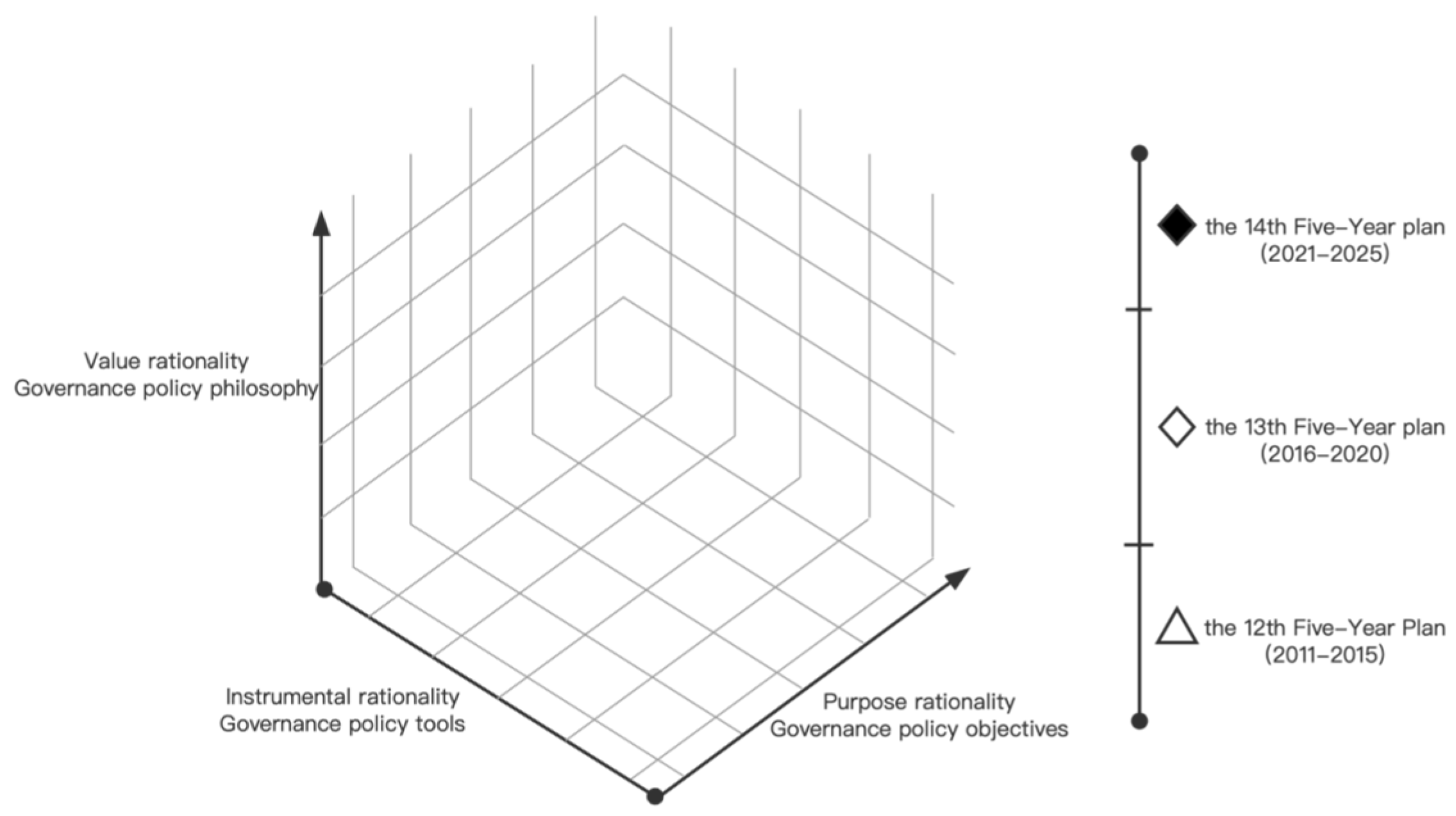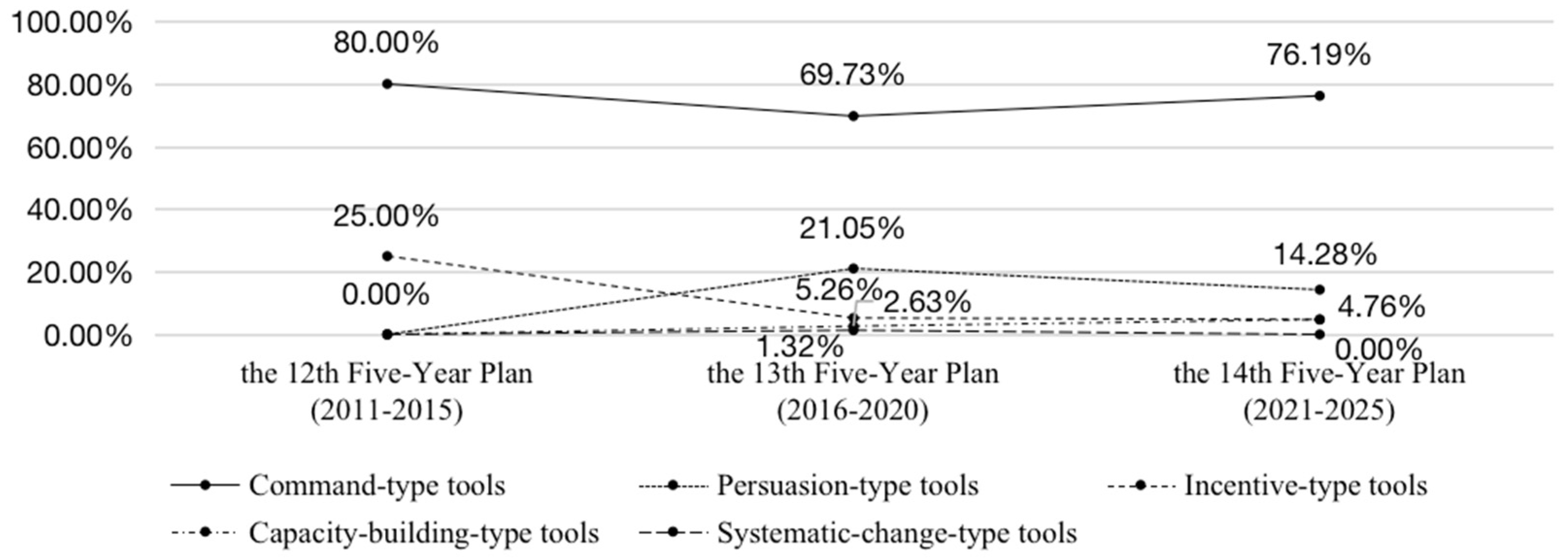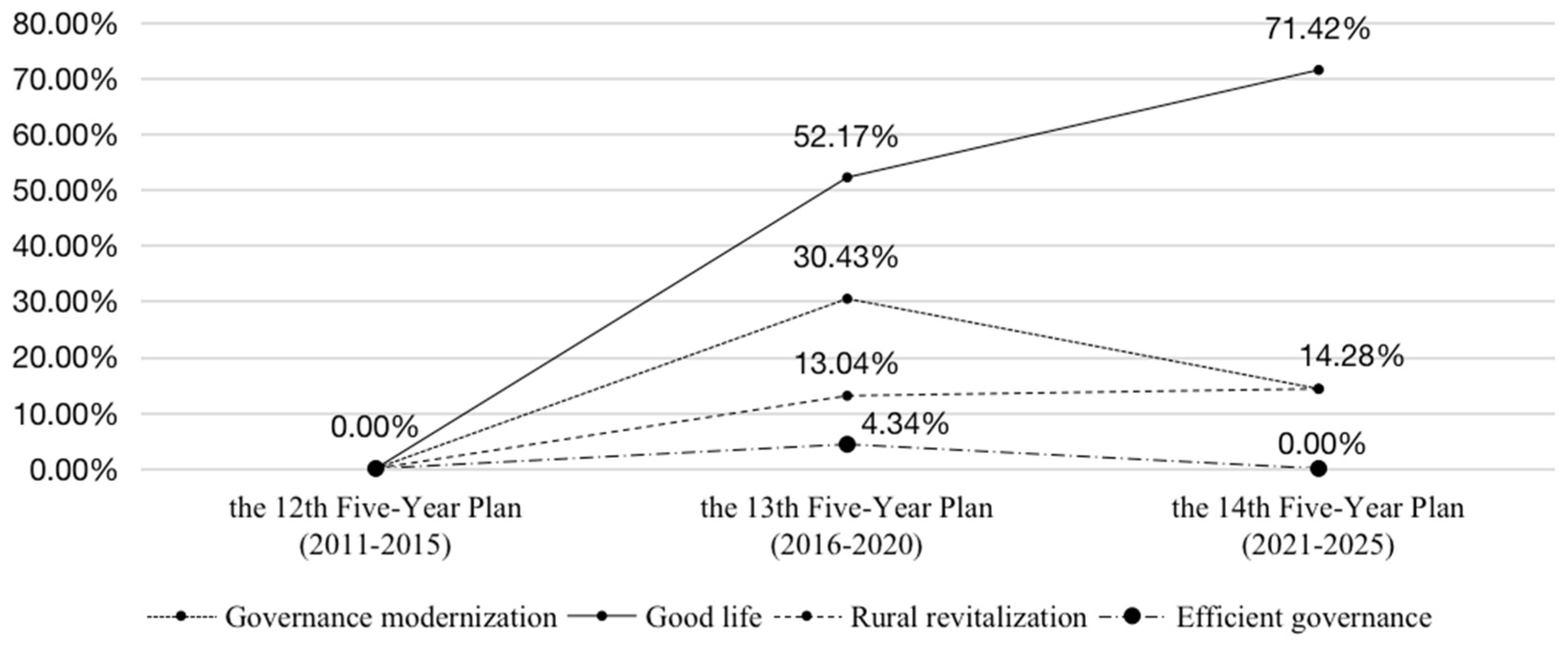What Is the Rational Choice of Community Governance Policy
Abstract
1. Introduction
1.1. Background
1.2. Literature Review
2. Methods
2.1. Sample Selection
2.2. Measures
2.2.1. Value Rationality
2.2.2. Instrumental Rationality
2.2.3. Purpose Rationality
3. Results
3.1. Encode Results
3.2. Reliability and Validity
3.3. Descriptive Statistics
3.4. Analysis Framework
3.4.1. Analysis of Value Rationality
3.4.2. Analysis of Instrumental Rationality
3.4.3. Analysis of Purpose Rationality
4. Discussion
5. Conclusions
Author Contributions
Funding
Institutional Review Board Statement
Informed Consent Statement
Data Availability Statement
Conflicts of Interest
References
- Wan, L.; Jiang, S. Research on the Influencing Factors of Sustainable Development of Smart Community. Math. Probl. Eng. 2022, 2022, 8420851. [Google Scholar] [CrossRef]
- Qian, Y.; Huang, J.; Zhao, L.; Cheong, I.H.; Cao, S.; Xiong, L.; Zhu, Q. Which Matters More in Fighting COVID-19—Government Policy or Community Participation? Front. Public Health 2022, 10, 927553. [Google Scholar] [CrossRef] [PubMed]
- Kim, D.J.; Salvacion, M.; Salehan, M.; Kim, D.W. An empirical study of community cohesiveness, community attachment, and their roles in virtual community participation. Eur. J. Inf. Syst. 2022, 1–28. [Google Scholar] [CrossRef]
- Li, S.; Liu, Z.; Ye, C. Community Renewal under Multi-Stakeholder Co-Governance: A Case Study of Shanghai’s Inner City. Sustainability 2022, 14, 5491. [Google Scholar] [CrossRef]
- Lian, X.; Li, D.; Di, W.; Oubibi, M.; Zhang, X.; Zhang, S.; Xu, C.; Lu, H. Research on Influential Factors of Satisfaction for Residents in Unit Communities—Taking Ningbo City as an Example. Sustainability 2022, 14, 6687. [Google Scholar] [CrossRef]
- Shan, F.F. On Urban and Rural Community Governance Policy from Policy Instruments Perspective—Taking Suggestions on Strengthening and Improving Urban and Rural Community Governance as an Example. J. Northwest Norm. Univ. 2020, 4, 87–94. [Google Scholar]
- Wang, X.J.; Wang, Z.Q. Government-Civilian Interaction, Public Values and Government Performance Improvemen—An Empirical Study of Government Micro Blogs of Beijing, Shanghai and Guangdong. J. Public Manag. 2017, 14, 31–43+155. [Google Scholar]
- Gates, C. Community governance. Futures 1999, 31, 519–525. [Google Scholar] [CrossRef]
- Di, X.X.; Li, S. The Double Variation of Party Building at the Grass-Roots Level and Grass-Roots Governance—Research Review of the Party Building Leading Innovation in Grass-Roots Governance. J. Party Sch. Tianjin Comm. CPC 2021, 1, 13–20. [Google Scholar]
- Lu, W.; Zhao, X.P.; Zhang, C.C. The Research of the Reasons and Countermeasure for Policy Failure of Urban Community Governance in China: From Policy Analysis Perspective. Urban Dev. Stud. 2016, 8, 107–112. [Google Scholar]
- Wu, J.B.; Cui, M.F.; Li, Y. How to Achieve Refined Emergency Prevention and Control Through Grid Management—Based on the Perspective of Policy Enforcement. Hubei Soc. Sci. 2021, 12, 32–38. [Google Scholar]
- Gui, Y. Choice of Community Governance Path—Analysis of Policy Networks. J. Yunnan Adm. Coll. 2014, 3, 103–106. [Google Scholar]
- Heng, X. The Public Choice Logic for Modernizing the Governance Capacity of Rural Communities—Based on the Analysis of 150 policy texts in 15 provinces of China. Probe 2021, 4, 38–48+2. [Google Scholar]
- Zhang, F. The Contradiction andIntegration of Urban and Rural Community Policies in the Context of Rural Revitalization. Study Explor. 2021, 2, 42–47. [Google Scholar]
- Xiong, C.; Zhang, Y.; Zhang, L.; Xie, J. Research on the strategic performance evaluation system of chinese local government promoting the informatization of rural community governance: Based on the BSC. Custose Agronegocio Line 2018, 14, 284–297. [Google Scholar]
- Zhao, X.F.; Feng, R.B. Top Level Design for the Development of Rural Governance: Policy Evolution and Prospects—Review of Policies Based on the “No. 1 Documents”. J. Tianjin Adm. Inst. 2018, 2, 58–66. [Google Scholar]
- Gao, Y. Current Situation and Optimization Path of Community Governance Policy in China—Analysis Based on Multi—Source Flow Theory. J. Inn. Mong. Norm. Univ. 2022, 1, 65–71. [Google Scholar]
- Gou, H. Text of China’s Community Governance Policy: An Analytical Framework for Activism. J. Wuhan Univ. Sci. Technol. 2018, 2, 151–157. [Google Scholar]
- Chen, J.G. How to Choose Governance Policies in Urban Communities: A Normative Analysis Framework. J. Public Adm. 2020, 2, 42–46+204. [Google Scholar]
- Wang, J.S. Tool Preferences and Optimization Paths for Community Governance Policies—Two-dimensional Analysis Based on Policy Tools and Governance Subjects. J. Party Sch. XPCC CPC 2019, 5, 73–78+91. [Google Scholar]
- Yang, W.W.; Guo, S.L. The Structural Contradiction of Government-led Community Governance and its Generation Mechanism—Based on the Research on the Policy Change and Consequences of Installing Elevators in S City. Study Pract. 2020, 8, 86–95. [Google Scholar]
- Wang, G.C.; Gao, H. The Central Government Promotes Research on Attention Allocation in Urban Community Governance—Based on Textual Analysis of Central Policy Documents from 1986 to 2019. J. Party Sch. CPC Qingdao Munic. Comm. Qingdao Adm. Inst. 2020, 2, 60–65. [Google Scholar]
- He, S.H. 70 Years of Policy Evolution and Urban Community Governance (1949–2019). Seeker 2019, 3, 79–87. [Google Scholar]
- Gao, F. From Government-market to Urban-rural Relationship: China’s Economic Transition from the Perspective of Structural Interaction. Explor. Free. Views 2019, 12, 95–103+159+161. [Google Scholar]
- Hilal, A.H.; Alabri, S.S. Using NVivo for data analysis in qualitative research. Int. Interdiscip. J. Educ. 2013, 2, 181–186. [Google Scholar]
- Gaitonde, R.; San Sebastian, M.; Muraleedharan, V.R.; Hurtig, A.K. Community action for health in India’s National Rural Health Mission: One policy, many paths. Soc. Sci. Med. 2017, 188, 82–90. [Google Scholar] [CrossRef] [PubMed]
- van den Hoogen, Q.L. New local cultural policy evaluation methods in the Netherlands: Status and perspectives. Int. J. Cult. Policy 2014, 20, 613–636. [Google Scholar] [CrossRef]
- Lyytimäki, J. Evaluation of sustainable development strategies and policies: The need for more timely indicators. Nat. Resour. Forum 2012, 36, 101–108. [Google Scholar] [CrossRef]
- Guo, Y.C.; Dai, S.Y. The Structual Dilemma of Urban Grassroots Community Governance from the Perspective of Policy Network—An Empirical Research Based on Micro-renewal of Shanghai A Street Office. J. Northeast. Univ. 2020, 4, 57–65. [Google Scholar]
- Weber, M. Economy and Society: An Outline of Interpretive Sociology; University of California Press: Berkeley, CA, USA, 1978; Volume 2. [Google Scholar]
- Song, D.X. Dialectical Rationality, Practical Rationality and Value Rationality of Socialist Political Economics with Chinese Characteristics. Social. Stud. 2022, 2, 62–69. [Google Scholar]
- Zhang, W.K. Collaborative Symbiosis: The Inheritance Logic and Development Trend of the Concept of Grassroots Social Governance. J. South China Norm. Univ. 2022, 4, 123–134+207. [Google Scholar]
- Weber, M. Methodology of Social Sciences; Routledge: Oxfordshire, UK, 2017. [Google Scholar]
- Zhang, M.J. Instrumental Rationality and the Form of Liberal Political Romanticism. Acad. Mon. 2021, 12, 85–95. [Google Scholar]
- Bressers, J.T.; Klok, P.J.; O’Toole, L.J., Jr. Explaining Policy Action: A Deductive But Realistic Theory. In Proceedings of the IPSA World Congress, Quebec City, QC, Canada, 31 July–5 August 2000. [Google Scholar]
- Hegel, G.W.F. The Logic of Hegel; Clarendon Press: Oxford, UK, 1874. [Google Scholar]
- Wang, Z. State Infrastructural Power: The Development Logic of Urban Grassroots Governance Changes and Modernization—Take Organization-technology-rule as the Analysis Framework. Social. Stud. 2022, 4, 115–123. [Google Scholar]
- Elkin, S.L. Economic & Political Rationality. Polity 1985, 18, 253–271. [Google Scholar]
- Sabatier, P.; Mazmanian, D. The conditions of effective implementation: A guide to accomplishing policy objectives. Policy Anal. 1979, 5, 481–504. [Google Scholar]
- Phillips, M.; Lu, J. A quick look at NVivo. J. Electron. Resour. Librariansh. 2018, 30, 104–106. [Google Scholar] [CrossRef]
- Shi, Y.T. The Realization and Function Mechanisms of “Governance Cluster”: Take “Social Conflicts and Disputes Mediation Center” as an Example. Nanjing J. Soc. Sci. 2021, 12, 84–90+117. [Google Scholar]
- Schneider, A.; Ingram, H. Behavioral assumptions of policy tools. J. Politics 1990, 52, 510–529. [Google Scholar] [CrossRef]
- McLaverty, P. (Ed.) Public Participation and Innovations in Community Governance; Taylor & Francis: Oxfordshire, UK, 2017. [Google Scholar]
- O’Toole, K.; Burdess, N. New community governance in small rural towns: The Australian experience. J. Rural. Stud. 2004, 20, 433–443. [Google Scholar] [CrossRef]
- Herzberg, B. Community service and critical teaching. In Dialogue on Writing; Routledge: Oxfordshire, UK, 2013; pp. 449–462. [Google Scholar]
- Fallowfield, L. What is quality of life. Health Econ. 2009, 1, 1104–1109. [Google Scholar]
- Tang, R.W.; Wang, Y.J.; Li, C.Q. Theoretical Construction of People’s Livelihood Development Based on Being, Livelihood and Libing: On the Political Economy of Socialism with Chinese Characteristics. China Econ. Stud. 2022, 2, 14–27. [Google Scholar]
- Zhou, M.; Hao, Y.Q. Achieving a Better Life Requires Building an Urban Community: Learning XI Jinping’s Important Exposition on Community Governance. Stud. Party Gov. 2022, 6, 81–89+127. [Google Scholar]
- Xiang, J.Y. The New Form of Human Civilization That Creates a Better Life. Teach. Res. 2022, 10, 35–43. [Google Scholar]
- Anderson, J. Marxist philosophy. Australas. J. Psychol. Philos. 1935, 13, 24–48. [Google Scholar] [CrossRef]




| Type | National | Eastern Region | Central Region | Western Region | Total | ||||
|---|---|---|---|---|---|---|---|---|---|
| Fujian, Guangdong, Hebei | Anhui, Hubei, Heilongjiang | Gansu, Sichuan, Yunnan | |||||||
| Number | Quantity | Number | Quantity | Number | Quantity | Number | Quantity | ||
| Government Work Report | N-A | 10 | East-A | 30 | Center-A | 30 | West-A | 30 | 100 |
| National economic development planning, Civil affairs development planning, Community governance development planning | N-B | 18 | East-B | 15 | Center-B | 15 | West-B | 15 | 63 |
| Total | 28 | 45 | 45 | 45 | 163 | ||||
| The 12th Five-Year Plan (2011–2015) | The 13th Five-Year Plan (2016–2020) | The 14th Five-Year Plan (2021–2025) | ||
|---|---|---|---|---|
| Value rationality | New development concept | - | 32.25% | 44.44% |
| Integrated governance concept | - | 22.58% | 5.56% | |
| People-oriented concept | 100.00% | 45.16% | 50.00% | |
| Instrumental rationality | Command-type tools | 80.00% | 69.73% | 76.19% |
| Persuasion-type tools | - | 21.05% | 14.28% | |
| Incentive-type tools | 25.00% | 5.26% | 4.76% | |
| Capacity-building-type tools | - | 2.63% | 4.76% | |
| Systematic-change-type tools | - | 1.32% | - | |
| Purpose rationality | Governance modernization | - | 30.43% | 14.28% |
| Good life | - | 52.17% | 71.42% | |
| Rural revitalization | - | 13.04% | 14.28% | |
| Efficient governance | - | 4.34% | - | |
Disclaimer/Publisher’s Note: The statements, opinions and data contained in all publications are solely those of the individual author(s) and contributor(s) and not of MDPI and/or the editor(s). MDPI and/or the editor(s) disclaim responsibility for any injury to people or property resulting from any ideas, methods, instructions or products referred to in the content. |
© 2023 by the authors. Licensee MDPI, Basel, Switzerland. This article is an open access article distributed under the terms and conditions of the Creative Commons Attribution (CC BY) license (https://creativecommons.org/licenses/by/4.0/).
Share and Cite
Xiang, H.; Wang, X.; Wang, Y.; Yang, Y.; Yang, C.; Huang, X.; Bu, Y.; Wang, M. What Is the Rational Choice of Community Governance Policy. Sustainability 2023, 15, 2395. https://doi.org/10.3390/su15032395
Xiang H, Wang X, Wang Y, Yang Y, Yang C, Huang X, Bu Y, Wang M. What Is the Rational Choice of Community Governance Policy. Sustainability. 2023; 15(3):2395. https://doi.org/10.3390/su15032395
Chicago/Turabian StyleXiang, Hongxun, Xunhua Wang, Yue Wang, Yang Yang, Can Yang, Xinyi Huang, Yangfan Bu, and Menglong Wang. 2023. "What Is the Rational Choice of Community Governance Policy" Sustainability 15, no. 3: 2395. https://doi.org/10.3390/su15032395
APA StyleXiang, H., Wang, X., Wang, Y., Yang, Y., Yang, C., Huang, X., Bu, Y., & Wang, M. (2023). What Is the Rational Choice of Community Governance Policy. Sustainability, 15(3), 2395. https://doi.org/10.3390/su15032395





